Overview of the Japanese Economy
“There are four kinds of countries: developed countries, underdeveloped countries, Japan, and Argentina.” – Simon Kuznets (apocryphal)
Monetary policy remains a mystery, not only to journalists, but also to many smart professional economists, especially when it comes to a strange case like Japan. But it is probably better to start with the supply side of an economy first.
Japan’s supply side is much stronger than most people realize. They are one of the richest countries in the world, with average incomes approximately equal to the United States. Japan’s economy is driven by demographics. A significant portion of the population is in its retirement years, and so measuring Japan’s economy on a per-worker basis produces a more positive vision of the country’s economy. Talk of the “Lost Decades” makes less sense when Japan arrived in an arguably better position at the end than the U.S, once you account for unemployment and inequality. Japan’s unemployment is around 4-5% vs. the U.S.’s 8-10%, and their Gini coefficient is 37.6 vs. 45.0 in the U.S.
Aggregate Demand
The big story of Japanese aggregate demand has been of a great conflict between the Bank of Japan (BOJ) and the Japanese National Diet (the legislature). The Diet has wanted higher inflation and attempted to achieve it through fiscal policy. Between 1991 and 2005, the Japanese debt to GDP went from “reasonable” to “Holy crap how can they borrow that much without their economy collapsing? That’s amazing!”. The total effect on the price level was perhaps 2% over the entire 14 year period (not per year), mostly from the period between 1996 and 1998. Once the BOJ realized the magnitude of the fiscal stimulus, they simply offset the effect using monetary policy and kept prices stable. If you learn nothing else from Japan, the lesson you should take away is that even with debt over 200% of GDP, the legislature cannot overpower a determined central bank.
The price level is pegged down by the level of spending and the level of production. If an economy produces $1 billion worth of goods, measured in U.S. dollars, and the level of spending in that country’s local currency is 5 billion units of currency, then the price level will be 5 times higher.
Using the equation of exchange:
MV = PY
P = MV/Y
Prices = (Spending)/(Output)
Japan has a fairly high savings rate compared to other developed countries. With such an elderly population, that isn’t too surprising, since the biggest thing most people save for is retirement.
When people save, they want a good return and a safe return, and there are tradeoffs between the two, at least in most financial theories. But remember that people choose what assets to invest in, they have to compare one asset to another. If one asset class is doing poorly, people move to other assets. The Japanese stock market has done terribly over the last two decades or so. Obviously there is no way to predict future performance from past returns, but to be honest, I don’t think many people expected to make money on the Nikkei in the 2000’s. Furthermore, Japanese government bonds have been earning next to nothing for a long time.
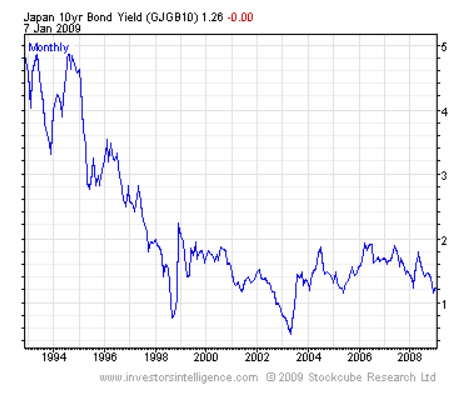
Keep in mind those are 10 year yields.
So what is a Japanese investor to do? Well, there is one option that looks a lot better in Japan than in many other countries: sitting on cash. Japan has experienced an extended period of mild deflation, and so every year you can buy a bit more with yen than you could before. Just as people minimize their cash holdings in periods of high inflation, they maximize their cash holdings in periods of deflation. Therefore, perhaps somewhat counterintuitively, in periods of prolonged deflation, the money supply often looks very large relative to the size of the economy. As David Hume once said, “If the coin be locked up in chests, it is the same thing with regard to prices, as if it were annihilated.”. A similar argument applies to government bonds. Even though investors aren’t making much money, at least they aren’t losing like they would in the Nikkei. That probably explains at least some of why the Japanese are content to hold such staggeringly large amounts of government debt.
Unlike many commentators, I don’t view Japan’s low inflation as a policy failure, per se. What matters is not what particular target the central bank has, but rather how well they do stabilizing it. Japan had much instability in the early 90s, but for the most part, the markets have long since settled down since then.
Japanese Price Stability – Varies about 3.5% in the last 20 years

U.S. Price Stability – Varies about 7.5%
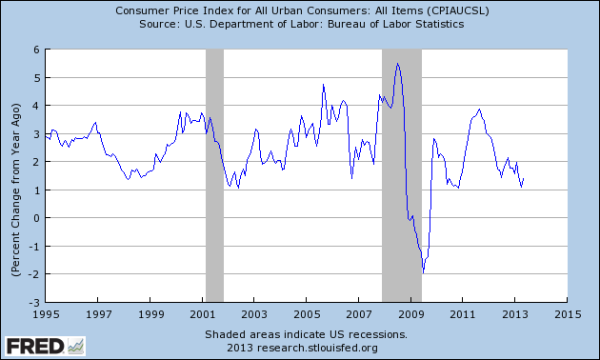
While Japan’s real GDP has decreased, there is nothing a central bank can do about that, and it has been mirrored by a decline in their working population. Simply put, the fewer workers you have, the lower your production will be. No amount of money printing can reverse that trend.
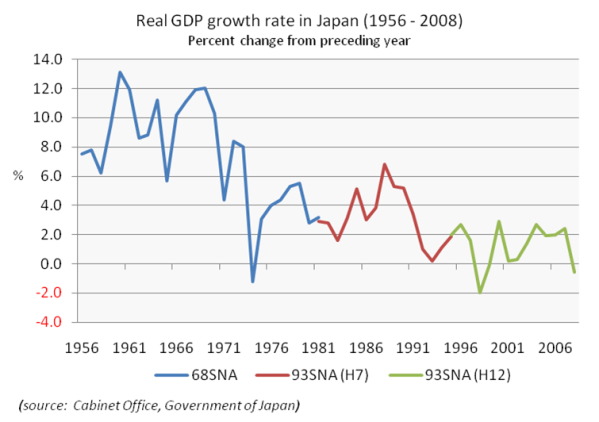
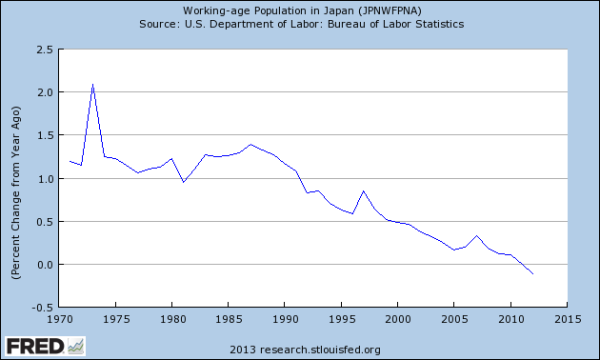
In the short run, lower than expected inflation/NGDP can harm an economy. But let’s be frank here, 20 years is no short run. To some, it’s surprising to many just how long downward nominal wage rigidity can last. But let’s think about it from the worker’s perspective. Workers don’t follow inflation statistics; they get “noisy signals” and are backwards looking with respect to their inflation expectations. It’s reasonable to have downwardly rigid wages when you are used to moderate inflation – lower nominal wages mean you get significantly lower real wages.
Kuroda and Yamamoto (2003) find that Japanese wages were downwardly rigid from 1993 to 1998, but that’s not altogether surprising since a worker in that time period still faced moderate recent inflation (see graph above). Kimura and Ueda (2001) found that wages were downwardly rigid in Japan until 1999, but downwardly flexible thereafter. Unfortuately, I can’t find a good study which includes data until 2007, at which point deflation was consistently below 0 for many years, but that’s probably because it’s so recent. However, the extremely low rates of Japanese unemployment would suggest that wage rigidity is not a major problem.
Abenomics
Recently, Shinzo Abe has launched a program designed to increase Japan’s inflation rate. So far, it seems to be working at achieving said goal. When I first heard about it, I was optimistic, as too-low NGDP growth has been a major problem for the U.S. and Europe lately, and I had assumed it was for Japan as well. Now that I have looked into the issue a bit more, I am not so sure. Japan’s labor markets seem to be quite flexible, with many people working temp jobs. While that might not be for the best in the long run, it at least prevents negative nominal shocks from translating into high unemployment. If the Japanese people expect stable prices and get stable prices, there shouldn’t be any problem with that. As always, monetary policy is most damaging when it is unexpected.
One interesting tidbit is that just as Abenomics is started up the Diet is passing a significant tax increase. Fiscal policy has been the focus of the pro-stimulus advocates in Japan during the Lost Decade(s), but this is an admission of failure on their part. To engage in contractionary fiscal policy and expansionary monetary policy while publicly expressing a desire for more inflation is to admit that monetary policy can overpower fiscal policy. After running massive deficits for an extended period with no inflation to show for it, a peace treaty between the two macroeconomic policymakers is well in order.
Another implicit admission of Abenomics is that monetary policy can still steer the economy in a liquidity trap. Despite 0% rates since basically forever, the BOJ has no problem increasing inflation now with little to no lag. If Japan, the poster child for the liquidity trap can increase inflation, anyone can.
Further Reading
Krugman on Japan.
Japan and NGDP targeting
Analysis of Japan’s unemployment
The Myth of Japanese failure
The Economist on the Lost Decades
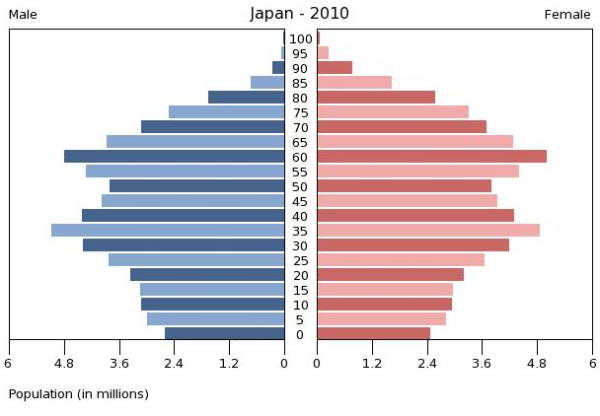
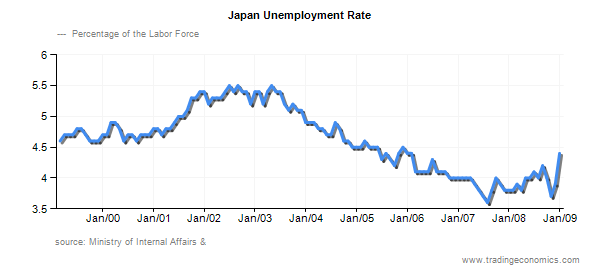
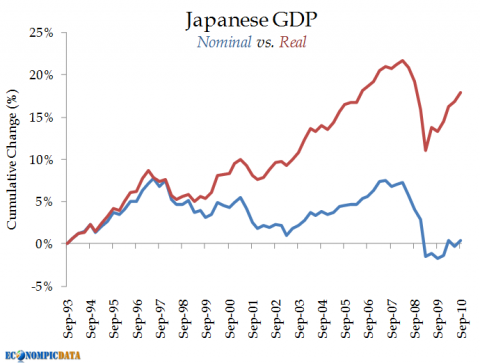

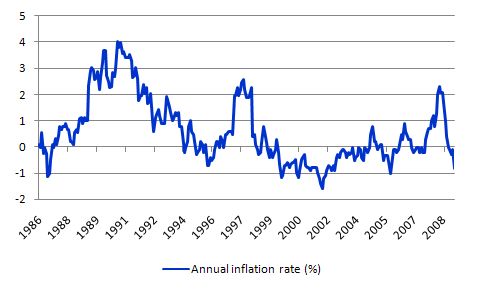


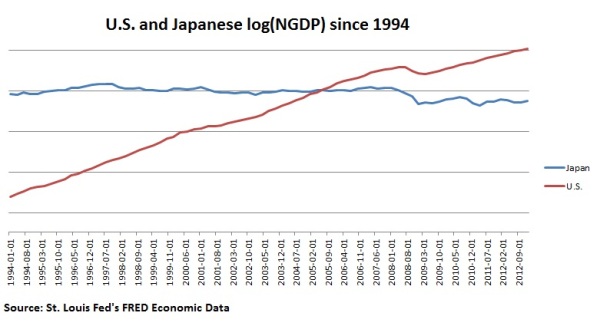
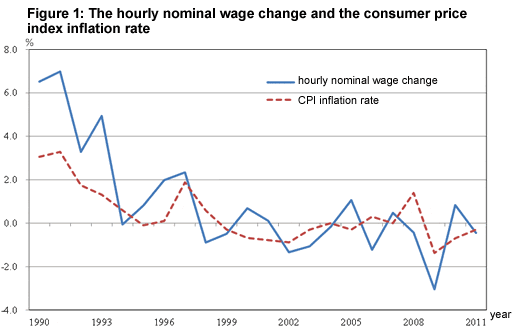



Very interesting.
Forgive me that I don’t know much about economics: What exactly did Japanese do (or what are main characteristics of Japan’s demographics) to have such a strong economy? And why other countries, for example Europeans (except Germany), could not do it?
It’s really hard to figure out precisely what makes some countries rich and others poor. Every country has its own unique attributes that others might not be able to emulate. Japan is actually a bit poorer than the UK, Canada, Germany, and Australia, but it is richer than France, Italy or Spain. Countries in this income category tend to be stable, low-corruption liberal democracies with free trade, open capital markets, relatively free labor movement (workers can pick their jobs freely), and other economic freedoms. France, Italy and Spain have more interventionist governments than Japan, and are facing the Euro crisis currently, so perhaps it is unfair to compare them right now to Japan.
In terms of stability and low unemployment, it helps to have your own central bank, like the U.S. or the U.K. The European Central Bank has to pick one policy which affects dozens of countries. Thus, its decisions might not be the best for any particular country, since they must weigh the pros and cons to the Eurozone as a whole. In the long run, low unemployment is usually related to factors which make it easy for people the enter the labor market, such as low regulation, low minimum wages, a good educational system, and perhaps apprenticeship/internship programs.
For more on development, you can read this:
Thanks a lot. It was really helpful.
Well the news is saying that japanese middle class income has shrank drammatically in relation to their government debt. Nowadays many young couple cannot dare to have child over there. Something out of text book case is cooking up there.
Unfortunately, that implies they are really stuck because low fertility just makes the problems worse.